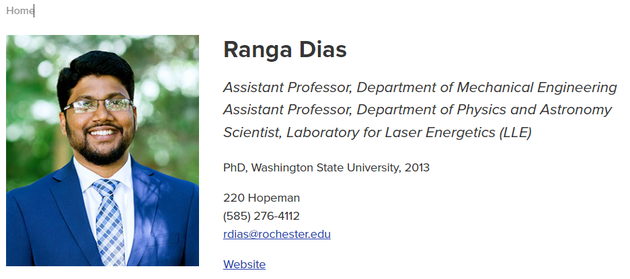
Photo/ University of Rochester website
A paper in Nature reports the discovery of a superconductor that operates at room temperatures and near-room pressures. The claim has divided the research community.
The results, published in Nature appear to show that a conventional conductor — a solid composed of hydrogen, nitrogen and the rare-earth metal lutetium — was transformed into a flawless material capable of conducting electricity with perfect efficiency.
National Business Daily (NBD) had an exclusive interview with Ranga Dias, the physicist at the University of Rochester who published the article with his team.
In the interview, Ranga Dias said that he and his team see this technology as a technology that will reshape the 21st century, but also pointed out that there are several years of hard work ahead to bring this discovery to real-world applications on any scale.

Ranga Dias Photo/ University of Rochester website
NBD: Would you give us more details on the newly-discovered material made of hydrogen, nitrogen and lutetium? How reliable is the new material? How does it differ from previously discovered carbonaceous sulfur hydride?
Ranga Dias: The details on the experimental work is now available in Nature. We are very excited about this new material and the processes required to achieve superconductivity. Of course significant more work needs to be done to develop the technologies and applications now theoretically possible.
NBD: Given your team's 2020 paper on the discovery of superconductivity in carbonaceous sulfur hydride at 15° C (SN: 10/14/20) was retracted by Nature, do you have confidence that the claim announced this time will pass scrutiny?
Ranga Dias: We are confident for several reasons – first, the work was repeated several times, both in our UR lab and in other labs, with third-party observation and independent verification of the work. Second, our paper was peer reviewed and held to the rigorous standard of the publication.
We also have resubmitted our 2020 paper for consideration by Nature, since the issue raised by Nature’s editors had no bearing on the quality of the data or the conclusions we reached. We are confident that in the quality of the 2020 work as well.
NBD: If your claim this time passes scrutiny, what symbolic meaning would it have for the superconductivity industry, and what does it mean for the world?
Ranga Dias: It is a game-changer – it makes possible a range of technologies that would transform the way we use, store and transmit energy – not to mention multiple applications in computing, transportation, and medical devices. We see this as a technology that will reshape the 21st century.
NBD: Based on the fact that "at temperatures as high as about 70° Fahrenheit, the newly-discovered material seemed to lose any resistance to electrical flow, but it requires pressures of 10 kilobar, which is about 10,000 times the pressure of our atmosphere", could "room temperature superconductivity" be applied on a large scale in the short term? What would be some of the difficulties people must overcome before they apply on a larger scale?
Ranga Dias: There are several years of hard work ahead to bring this discovery to real-world applications on any scale. The challenges are technical in nature, but they are surmountable.


 川公网安备 51019002001991号
川公网安备 51019002001991号





